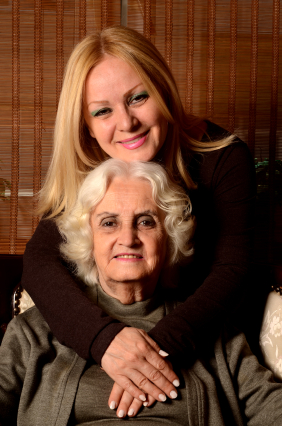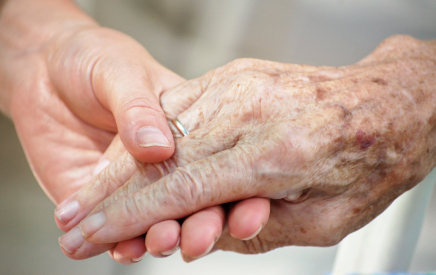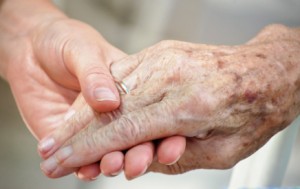Category: Transitions in care
Posted by Dr. El - July 15, 2015 - Communication, Dementia, Inspiration, Technology, Transitions in care

I wrote about the White House Conference on Aging last October, noting that it was a “once-a-decade” national conference about the needs of our aging population.” (McKnight’s LTC News, October 2014)
Below, LeadingAge summarizes the 2015 White House Conference on Aging, which took place on Monday:
After a year’s worth of collecting data and opinions, experts from the field of aging presented new ideas and initiatives at the 2015 White House Conference on Aging (WHCOA).
The White House Conference on Aging facilitated a national conversation on growing older in America through live-streaming social media. LeadingAge hosted a watch party and found the following highlights noteworthy:
- A Call for Caregiver Support Systems: Panelists stressed the importance of establishing support systems for the nation’s 50 million professional and family caregivers, whose numbers will double by the year 2050.
- CMS Proposed Rule: CMS proposed Reform of Requirements for Long-Term Care Facilities, which would affect more than 15,000 nursing homes and skilled nursing facilities. A element of the proposal is new standards for coordinating facility-to-facility patient transfers in order to improve quality of life, enhance person-centered care and services for residents in nursing homes, and improve resident safety.
- HHS Secretary Announces Funding for Workforce: Sylvia Burwell, secretary of the U.S. Department of Health and Human Services (HHS) announced $35.7 million for a new Geriatric Workforce Enhancement Program, preparing the health care workforce to respond to the needs associated with advancing age.
- Dementia Friendly America: A coalition of private sector organizations announced the Dementia Friendly America initiative, which was created to foster communities that are equipped to support people with dementia and their families. There are currently plans to build 15 new pilot sites across the country.
For the rest of the article, visit:

Posted by Dr. El - April 1, 2015 - Communication, End of life, McKnight's Long-Term Care News, Resident care, Transitions in care

Here’s my latest article on McKnight’s Long-Term Care News:

As a psychologist observing the effects of medical interventions on the mental health of the long-term care resident, I often ask, “Is this aggressive procedure helping?”
Such a well-intended question can prompt the team to reconsider the course of treatment or to affirm that care is in line with the wishes of the resident and their family.
Conversely, I do what I can to encourage my residents to comply with medical recommendations. When a resident presents with end-stage renal disease (ESRD) and the inevitable recommendation of hemodialysis is given, I work with them to adjust to this turn of events.
That’s why I was surprised to read in Paula Span’s “New Old Age” article in the New York Times last week, “Learning to Say No to Dialysis,” that dialysis isn’t always the best course of treatment for older patients.
Span reports that while dialysis can be very successful for younger and healthier patients, about 40% of patients with ESRD over the age of 75 die within a year and only 19% survive over four years. One study found that 58% of nursing home residents died within a year. Meanwhile, 61% of patients in a Canadian study said they regretted starting dialysis.
What leads to regrets tend to be the following factors, which can contribute to feelings of depression among those on a renal program:
• Physical symptoms such as pain, fatigue, nausea and headaches
• The amount of time spent on dialysis
• Inability to travel
• Dietary restrictions
Span quotes nephrologist Dr. Alvin H. Moss, who notes, “Patients are told, ‘You have to go on dialysis or you’ll die,’ rather than, ‘You could have up to two years without the treatment, without the discomfort, with greater independence.’” I’ve been part of teams that have told residents the exact words of that first message.
Medical management
For older patients, particularly those with other health problems, Dr. Moss asserts that medical management might be a way for them to focus on extending their quality of life and avoiding the discomforts of dialysis. The American Society of Nephrology suggests discussing this alternative to dialysis with patients through a shared decision-making process, as noted in their Choosing Wisely guidelines.
Facilitating treatment discussions
For the entire article, visit:

Posted by Dr. El - December 3, 2014 - CareConversations.org, For Families, Transitions in care

My second post at Care Conversations.org focuses on easing the transition to long-term care for families.
As a psychologist, I’ve talked with hundreds of residents as they transition to living in a Skilled Nursing Care center. In the privacy of a psychotherapy session, new residents will frequently share with me things they haven’t mentioned to their families, often because they don’t quite know what to say or how to say it.
Their perspectives may surprise you:
- They’re worried about you. They’re concerned about how much time you’re spending at the facility. They worry you’re neglecting yourself and your life. They want you to take care of yourself because they love you and because they need you – so take their advice and do so!
- They know you’ve done your best. In most cases, new residents are aware they would have been admitted to a long-term care facility much sooner if it hadn’t been for you. While they may not be happy about the transition initially, they know that without you they would have been here long ago.
For the entire article, visit:

Posted by Dr. El - December 1, 2014 - CareConversations.org, For Families, Transitions in care

I’m excited to let you know about my recent post for family members at Care Conversations.org. Readers who are long-term care staff members will find it a helpful resource to share with family members.
Moving to an assisted living or a skilled nursing facility can be challenging for both you and your loved one. To help make the transition less stressful, it’s often suggested that family members work with staff to ensure their loved one’s needs are being met. Here are some ways to become a valuable player on the nursing home team:
- Keep an open mind – It is normal to feel nervous about placing a loved one in a long-term care facility. But as our loved ones grow older and begin experiencing more and more health issues, their needs are often best met by skilled nursing facilities. Entering a facility with an expectation of good care puts you in a teamwork frame of mind.
- Recognize the expertise of LTC workers – Nobody knows Mom, Dad or Aunt Sue like you do, but chances are that you haven’t handled a situation quite like this before. By contrast, those who work with elders have observed hundreds of similar situations and bring a vast amount of knowledge and experience to the care of your loved one. It’s good to have them with you on this journey.
- Appreciate your essential role on the team —
For the entire article, visit:

Posted by Dr. El - September 20, 2013 - Business Strategies, Common Nursing Home Problems and How Psychologists Can Solve Them, Depression/Mental illness/Substance Abuse, McKnight's Long-Term Care News, Role of psychologists, Transitions in care

Here’s my latest article on McKnight’s Long-Term Care News:

Of the most efficient countries for healthcare, the United States ranks second in healthcare costs per capita but 46th in efficiency (out of the 48 countries ranked!). The move from a biomedical to a biopsychosocial model of healthcare might be able to change that.
Consider the following scenario: Estelle’s fall at home sent her to the hospital. She was diagnosed with a hip fracture and diabetes and transferred to the nursing home for short-term rehab. A biomedical model would treat both conditions and send her home again. A biopsychosocial model would also address her need to make dietary changes, her fears of falling again, the alcoholism that contributed to both her diabetes and her fall, and her noncompliance with the rehab staff.
From biomedical to biopsychosocial
In her American Psychological Association presidential address, psychologist Suzanne Bennett Johnson discussed the change from a biomedical model of care to a biopsychosocial model of healthcare. The biomedical model of care that has “dominated Western medicine … for over 100 years” focuses solely on biologic factors to understand illness. It’s resulted in cures for infectious illnesses such as tuberculosis, pneumonia, and influenza, and increased life expectancy from 49 years in 1901 to 77 years in 2001. The biomedical model has been a great success in many respects.
As Johnson points out, however, “while infectious disease was the leading cause of death in 1900, today most Americans die of chronic disease: heart disease, cancer, chronic lower respiratory diseases, and stroke.”
Underlying these diseases are behaviors such as smoking, poor dietary habits, sedentary behavior, and substance abuse. In addition, she notes, “as many as 40% of medical patients are co-morbid for a mental health disorder and as many as 75% of seriously mentally ill patients are co-morbid for a physical health disorder.”
Implications for LTC
Clearly, in order to reduce chronic disease in this country (and to decrease medical costs), we need to address the behaviors – the psychological and social factors — underlying the diseases. But we work with elders, you might say, the damage caused by years of poor self-care has already been done! Perhaps.
But as a psychologist talking with seniors over the years, I’ve found that many of my lovely old dogs were ready for new tricks. We need to intervene, however, in certain key ways:
For the entire article, visit:

Posted by Dr. El - September 16, 2013 - Books/media of note, For Families, Transitions in care

Navigating the Caregiver’s Journey: Long Term Care Offers a Valuable Viewpoint
When my parents relocated from Memphis to Kansas City to be closer to me, they packed decades worth of clothes, souvenirs, books, and furniture. The process of helping them move overwhelmed me and I fervently wished they’d had fewer possessions. But three years later, I yearned for those stacks of boxes; my mother’s possessions had dwindled considerably since she’d progressed deeper into Alzheimer’s. Now she needed additional care and was moving from assisted living to a memory care facility.
That blustery September day, as my dad and I helped transfer my mom to her new home, Mom had only a suitcase full of clothes and toiletries.
Taking the First Steps
Once at the home, the administrator welcomed us but her cordial greeting couldn’t dispel the chill I felt. I had worried about moving Mom into this brand new facility, but the home was close to my dad, who was already having some trouble driving.
“Where is…?” my mother asked, tugging on her sweater. “What are…”
“We’re fine, Frannie,” my father said.
My stomach clenched as we walked into the shiny new unit. After we’d taken a few steps, a woman in a white nursing uniform hurried towards us.
“Frances, how lovely to see you. And you too Paul. You must be Deborah.” The woman, Pam, was the nurse in charge. Dad had met her earlier and had told me how nice she was.
“I’m so glad you’re all here,” Pam said. She turned to Mom and said, “Paul told me you were a nurse during World War II.”
“She was,” Dad said proudly. “She served in Iceland and England.”
”That was very courageous of you,” Pam said. She linked her arm through Mom’s and she and Mom strolled down the hallway together. “You must have had many adventures.”
Mom looked blank and then smiled. “We skied to hot springs.”
Some fragments of Mom’s WWII stories were still intact and Pam listened encouragingly as Mom shared phrases from the same story several more times. They settled at a table in the cozy dining room and Pam served us all coffee and cookies. She seemed relaxed and welcoming; she was getting to know a new friend.
Embracing a New Viewpoint
When I listened to my mom’s stories, I usually wrote down every word, worried I might not hear them again; I felt I was losing an old friend. But Pam wasn’t worried when Mom repeated herself or misplaced letters. She didn’t panic when Mom started a sentence and couldn’t retrieve her thought. Pam just wanted to get to know Mom. Through her actions, Pam silently invited me to appreciate my mother just as she was.
As I hung up my mother’s meager collection of clothes in her new closet, I was grateful for her pared-down possessions. Mom had let go of many material reminders of the past, just as I was letting go of the woman my mother used to be and embracing the woman she was. ##


Deborah Shouse: Bringing Words to Life
Deborah Shouse is a writer, speaker, editor and creativity catalyst.
This November, Central Recovery Press is going to publish an updated edition of her book Love in the Land of Dementia: Finding Hope in the Caregiver’s Journey. Originally, Deborah self-published and used the book as a catalyst to raise more than $80,000 for Alzheimer’s programs and research. She will continue donate a portion of her proceeds to Alzheimer’s.
Deborah and her partner Ron Zoglin have performed her writings for audiences in the United States, New Zealand, Nova Scotia, Puerto Rico, England, Ireland, Chile, Costa Rica, Italy, Turkey and the U.S. Virgin Islands.
To learn more about Deborah’s work, visit her blog DeborahShouseWrites
Or follow her on Twitter: DeborahShouse@Twitter
Posted by Dr. El - October 10, 2012 - Business Strategies, Common Nursing Home Problems and How Psychologists Can Solve Them, McKnight's Long-Term Care News, Transitions in care


Here’s my latest guest post on McKnight’s Long-Term Care News:
Long-term care psychologists are a valuable resource for facilities looking to reduce their hospital readmission rates. As the only team member whose role it is to sit and talk with the residents for an extended period of time on a regular basis, psychologists are privy to a relationship that can help address root causes of readmission such as medication noncompliance and the recognition and timely reporting of symptoms, as well as follow-through with medical appointments after discharge.
Psychologists can:
1. Notice mental status changes before other staff members. Because interactions are based on extended conversations with residents, psychologists are frequently able to spot subtle alterations in cognition that wouldn’t be noticed during a med pass or routine caregiving.
2. Discover previously unreported symptoms. Due to the amount of time psychologists spend with the residents and the level of trust that develops in the psychotherapeutic relationship, residents often reveal important symptoms of their illnesses they might not share with medical staff.
3. Gather information from communication-challenged residents. Psychologists can gather info from residents who speak slowly or need to use communication devices and then share it with the team, saving staff time and providing important details.
For more, visit McKnight’s LTC News:
__________________________
For more on how nursing home psychologists can help those in LTC:
Free Audio: Interview by Psychotherapist Bill O’Hanlon
In this audio, mental health expert Bill O’Hanlon talks with Dr. El about the role of nursing home psychologists and how their work can transform facilities and improve the lives of residents, families, and staff members.
Free Download!

____________________
Now available on Amazon:
Everything You Wanted to Know About Your Nursing Home Stay
But Were Afraid to Ask
Posted by Dr. El - April 2, 2012 - End of life, Resident care, Transitions in care
I read this worthwhile article by Susan Jacoby on the March 30, 2012 Opinion Page in the New York Times.
Susan Jacoby is the author of “Never Say Die: The Myth and Marketing of the New Old Age.”
I WAS standing by my 89-year-old mother’s hospital bed when she asked a doctor, “Is there anything you can do here to give me back the life I had last year, when I wasn’t in pain every minute?” The young medical resident, stunned by the directness of the question, blurted out, “Honestly, ma’am, no.”
And so Irma Broderick Jacoby went home and lived another year, during which she never again entered a hospital or subjected herself to an invasive, expensive medical procedure. The pain of multiple degenerative diseases was eased by prescription drugs, and she died last November after two weeks in a hospice, on terms determined by explicit legal instructions and discussions with her children — no respirators, no artificial feeding, no attempts to buy one more day for a body that would not let her turn over in bed or swallow without agony.
The hospice room and pain-relieving palliative care cost only about $400 a day, while the average hospital stay costs Medicare over $6,000 a day. Although Mom’s main concern was her comfort and dignity, she also took satisfaction in not running up Medicare payments for unwanted treatments and not leaving private medical bills for her children to pay. A third of the Medicare budget is now spent in the last year of life, and a third of that goes for care in the last month. Those figures would surely be lower if more Americans, while they were still healthy, took the initiative to spell out what treatments they do — and do not — want by writing living wills and appointing health care proxies.
For more: Taking Responsibility for Death
Posted by Dr. El - January 11, 2012 - Anecdotes, Communication, End of life, Resident care, Transitions in care

I hadn’t been on the North wing of the nursing home in a while, and when I saw Juanita Johnson sleeping in a geri-recliner, I turned to the nurse, aghast. “I barely recognized her! She’s lost so much weight!”
“I know. It’s terrible,” the nurse replied. “We’re having her evaluated by hospice today.”
Ms. Johnson was accepted into the hospice program, and died two days later.
I’ve seen many late referrals to hospice in my years as a nursing home psychologist. It’s the rare older resident who wants every treatment possible late in life. Most of the time, the resident is going along with the program, waiting for the doctor to say that it’s time to rethink how we’re handling things. The resident is waiting for “the conversation,” but all too often the conversation doesn’t happen until it’s too late. The resident’s last days and months are ones of unpleasant medical interventions rather than a time of comfort and emotional support. This affects their family as well, with the emotional ripples of a “bad” death living on for years.
It’s not so easy to determine when someone is dying, but this week’s article by Paula Span in the New York Times, Interactive Tools to Assess the Likelihood of Death, discusses the use of interactive tools and how they can help us make better end-of-life medical decisions. The tools are posted at ePrognosis.org.

Coping with Grief, for Staff Members: Conversation with grief expert Courtney Armstrong, LPC
 Beloved residents decline and then die, their families stop visiting the nursing home — coming to terms with these losses is an unacknowledged challenge of our work. Especially helpful for training directors, new employees, or those struggling with a current loss either on or off the job, this 20-minute audio will help staff members:
Beloved residents decline and then die, their families stop visiting the nursing home — coming to terms with these losses is an unacknowledged challenge of our work. Especially helpful for training directors, new employees, or those struggling with a current loss either on or off the job, this 20-minute audio will help staff members:
- Understand their feelings
- Recognize symptoms of grief
- Identify coping skills
- Assist each other in creating a supportive community
Includes FREE:
- Signs of Grief checklist
- LovingKindness Meditation Sign suitable for posting at the nursing station
Instant Download: Only $7.99

Posted by Dr. El - September 13, 2011 - Communication, Customer service, Resident care, Transitions in care


“What the f***!” Ms. Webster was red in the face, shouting at the nurse who’d just arrived for the evening shift. “The day nurse told me I was moving to the third floor — now you tell me I’m not? You people better get your s*** together!” She began hurling onto the bed the belongings she’d gathered into a giant trash bag earlier in the day. She muttered profanity as she did so.
“I’ll make some phone calls and find out what’s happening,” the evening nurse said nervously and then rushed out of the room.
There’s been a lot of attention paid recently to transitions in nursing care: moves between the hospital and nursing home, and moves between home and the hospital or nursing facility. Another transition that deserves attention is room changes within the nursing home. The importance of this passage is often overlooked, resulting in confusion, anxiety, and distress. Properly handled, room changes are an opportunity to create a positive customer service experience within your facility. Here are some points to consider:
- Prepare the resident (and family) for the change by informing them as far in advance as possible.
- Attend to the emotional reaction to the move, especially if it signals a shift from being a short-term resident to becoming a long-term resident. Consider a psychology referral to facilitate adjustment to the new floor rather than waiting until problems become entrenched.
- Try to make room changes early in the day so that one shift handles the entire transition.
- Do an “idiot check” to make sure all property is transitioned to the new room.
- Label clothing quickly and make the resident aware of the reason the clothing is missing.
- Provide an introduction of staff and a pleasant welcome to the new unit to reduce anxiety.
- Introduce the transferred resident to another resident or two with whom they might get along.
- Ask a long-time resident on the floor to welcome the new resident.
- Create a policy that guides transitions so that “short-term” floors stay short-term, avoiding the resentments that crop up when one resident is reluctantly moved while another resident who has been there longer remains on a supposedly short-term floor.



















 Beloved residents decline and then die, their families stop visiting the nursing home — coming to terms with these losses is an unacknowledged challenge of our work. Especially helpful for training directors, new employees, or those struggling with a current loss either on or off the job, this 20-minute audio will help staff members:
Beloved residents decline and then die, their families stop visiting the nursing home — coming to terms with these losses is an unacknowledged challenge of our work. Especially helpful for training directors, new employees, or those struggling with a current loss either on or off the job, this 20-minute audio will help staff members:
